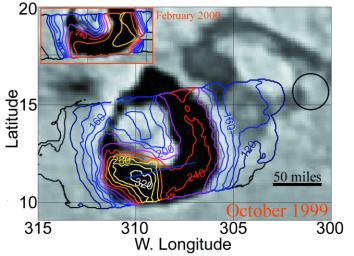
|
Temperature Comparison at Loki
- Click the image above for a larger view
- Full-Res JPEG (1060 x 767) (133.3 kB)
- Full-Res TIFF (1060 x 767) (291.5 kB)
Caption:
This image compares temperatures at the volcano Loki, the most powerful volcano on Io, seen by the photopolarimeter-radiometer instrument onboard NASA's Galileo spacecraft during its October 1999 flyby of Jupiter's moon Io (main image), and during its February 2000 flyby (inset). The hottest regions are within the huge, 200-kilometer (120-mile) wide caldera (the dark, horseshoe-shaped region in the image). Temperature contours are in degrees Kelvin (Kelvin): 160 K is -171 F and 320 K is +116 F. In the 4 1/2 months between the images, the hot region seen in October in the southwest part of the caldera disappeared, and the eastern part of the caldera became about 40 degrees Kelvin (70 degrees Fahrenheit) hotter. The temperature increase probably results from lava flows flooding over 10,000 square kilometers (4,000 square miles) of the caldera floor.
Background Info:
Additional information about the Hubble Space Telescope is available at http://www.stsci.edu/hst/ . Additional information about the Galileo mission is available at http://galileo.jpl.nasa.gov .
Cataloging Keywords:
| Name | Value | Additional Values |
|---|---|---|
| Target | Io | |
| System | Jupiter | |
| Target Type | Satellite | |
| Mission | Galileo | Hubble Space Telescope (HST) |
| Instrument Host | Galileo Orbiter | Hubble Space Telescope |
| Host Type | Orbiter | Space Telescope |
| Instrument | Near-Infrared Mapping Spectrometer (NIMS) | |
| Detector | ||
| Extra Keywords | Color, Volcano | |
| Acquisition Date | ||
| Release Date | 2000-05-18 | |
| Date in Caption | ||
| Image Credit | NASA/JPL/Lowell Observatory | |
| Source | photojournal.jpl.nasa.gov/catalog/PIA02549 | |
| Identifier | PIA02549 | |
